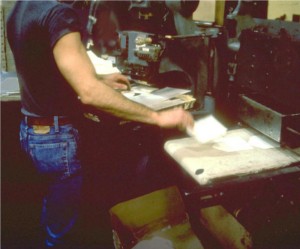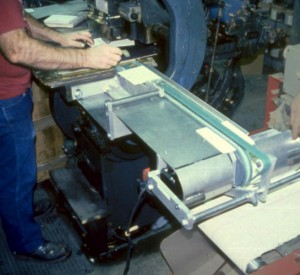[initial draft]
A good way to get ideas for feasible improvements is to look at automatic equipment. Often, in order to automate, engineers have devised mechanisms to handle parts or perform certain tasks that can be adapted for manual work. One or two features of the automated equipment can thus be “borrowed,” without needing to incorporate all of the expensive automation.
 |
 |
| Before | After |
A good example is shown above for engraving presses in a printing plant. The photo above left shows a completely manual operation, which required the operator to flip engraved cards by hand onto a conveyor going into a drying oven.
One of the ways that ergonomics provide value to production operations is that it helps to identify ways to improve operations without the expensive automation or capital equipment. Too often there is a tendency to think in all-or-nothing terms, i.e., that jobs are either done by brute force or high tech.
A reason that automation is sometimes prohibitively expensive is because of the attempt to eliminate the human completely, since it can be difficult to design machines to do certain things that humans do easily, such as seeing the location and orientation of materials or noticing when something goes wrong. Consequently, it can be more cost-effective to keep the human in the system, using people to do what we do best and machines to do what they do best.
